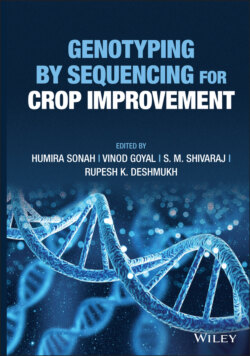Читать книгу Genotyping by Sequencing for Crop Improvement - Группа авторов - Страница 13
1.1 Introduction
ОглавлениеPlant selection and systematic breeding efforts led to the development of present‐day improved cultivars of crop plants. From a historical perspective, increased crop yield is the result of genetic improvement (Fehr 1984). Markers play an important role in the selection of traits of interest. Markers can be morphological, biochemical, or molecular in nature. Morphological markers are visual phenotypic characters such as growth habit of the plant, seed shape, seed color, flower color etc. Biochemical markers are the isozyme‐based markers characterized by variation in molecular form of enzyme showing a difference in mobility on an electrophoresis gel. Very few morphological and biochemical markers are available in plants, and they are influenced by developmental stage and environmental factors. Since a large number of economically important traits are quantitative in nature, which are affected by both genetic and environmental factors, the morphological and biochemical markers‐based selection of traits may not be much reliable. The subsequent discovery of abundantly available DNA‐based markers made possible the selection of almost any trait of interest. DNA‐based markers are not affected by the environment. Besides, these markers are highly reproducible across labs and show high polymorphism to distinguish between two genetically different individuals or species.
In the last four decades, DNA‐based molecular marker technology has witnessed several advances from low throughput hybridization‐based markers to high‐throughput sequencing‐based markers. These advances have been possible due to critical discoveries such as polymerase chain reaction (PCR) (Mullis et al. 1986), Sanger sequencing method (Sanger et al. 1977), automation of Sanger sequencing (Shendure et al. 2011), next‐generation sequencing (NGS) technologies (Mardis 2008), and development of bioinformatics tools. This chapter will briefly discuss different types of molecular markers while particularly focusing on recent developments in molecular marker technologies. These developments have expedited the mapping and cloning of several loci governing important traits, precise trait selection, and transfer into elite germplasm.
